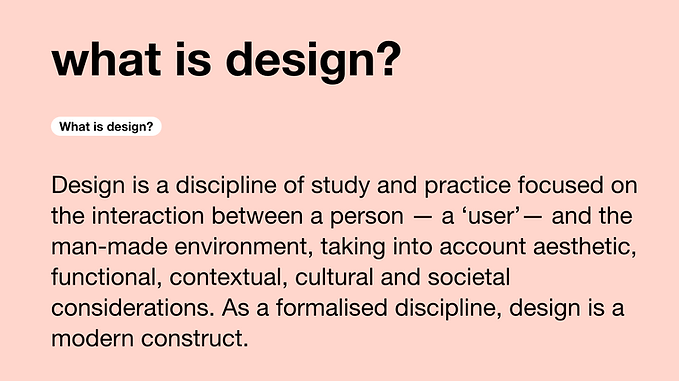Unit 1
Reflecting on Design
Project 1
1. Introduction
Understanding what design is, what designers do and what processes they follow is an important knowledge to acquire during the course. In Unit 1, you will be exposed to an introduction of the design field as you will reflect critically on design works as well as your own work. You will also learn to use the sketchbook and reflective questions to guide your own practice.
2. Learning outcomes
By the end of this unit, you will be able to:
> Explain what is design and what is a designer
> Analyse what graphic design field you prefer
> Explore and analyse the research process
> Explore how research leads to ideas
> Evaluate your practice in a sketchbook
> Explore zines made by other designers
1. What is design?
When you say ‘design’, what do you think of? Design is everywhere and all around us: from the notebook that you use everyday, the home you live in, the visual messages that you see outside, the APPs of your phone or even the layout of this page. To start, have a look at the definition of the International Council of Design.
DISCUSSION: Design is a problem-solving process that seeks solutions to all sorts of different needs, concerns and desires.
> What would be your definition of design?
> Do you see any difference so far between design and, for example, art?
2. What is a designer?
Within the profession we call ‘designers’ there are a spectrum of specialisations, including (1) visual communication designers/graphic designers, (2) industrial designers/product designers, (3) fashion/textile designers (4) interior designers (5) service designers (6) UI/ UX designers. Have a look here at the different design disciplines.
3. What is graphic design?
Graphic design is the craft of planning and creating visual content to communicate ideas and messages. Graphic design is everywhere you look in the digital age — from billboards to cereal boxes to mobile apps. Have a look at the image below can give you a broad idea of the sub-disciplines within the field of graphic design.
DISCUSSION
> Which field(s) of graphic design do you prefer to work in? Why?
> Which field(s) would you be interested to discover? Why?
1. Analysing the research process
Last week, you started the research process by completing different tasks, from searching inspiring images into books, going through websites and design projects, walking outside taking photographs of what catched your attention, organising your thoughts into a visual map, etc. The research process leads to your idea development.
DISCUSSION
> Which research task did you find more useful? Which one you didn’t?
> Why do we need to research to develop our ideas?
2. Design case study: A behind the scenes process
Now, consider one of my design works where the concept "borders and crossroads" was part of the starting point. Here are some images that show my process of work until designing the outcome as photographic zine, URBAN VISA. I saw the manholes being collected as passport stamps, as the entry and exit of an underground border, as the grid patterns of our streets, and I used photographs to design the zine.






Urban visa is a photographic zine that explores manholes as grid patterns and stamps in a fictional urban passport.
DISCUSSION
> How did I link the research together in my idea development?
> Why are experiments and tests important?
1. The sketchbook
Sketchbooks are used to document your practice visually. You could ask: Why should we record what we do? We could say that it is to keep a track on ideas, to visualise our work process, to reflect critically on what we do. Now, when asking: How should we record what we do? We could say by using images, videos, drawings, pieces of materials, etc. As you are doing workshops, ask yourself: What can you show from your experiments?








DISCUSSION: In your sketchbook, think back at the workshop(s) that you did in the last two weeks and start to reflect.
> What have you tried to make?
> What worked? What didn't? Why?
> What could you improve and do next?
2. The outcome
As graphic designer, you may want to design a zine as outcome in this project. Look at the different zine references shown by your teacher and reflect about content and structure.

DISCUSSION
> Which zine do you prefer? Why?
> Which structure do you find inspiring? Why?
> Why content elements do you find inspiring? Why?








